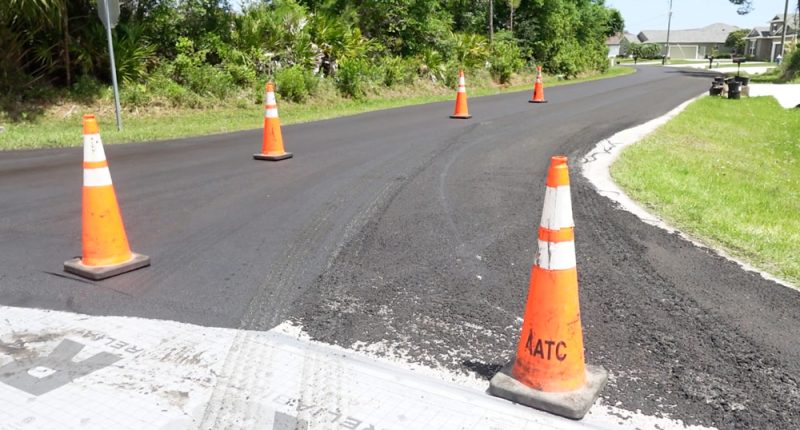
More than 30 residential streets in Palm Coast–23 lane miles, or 11.5 miles of roadway out of the city’s network of 542 miles of roads–are getting a life extension with a coating of micro-surfacing, a form of asphalt treatment for roads in relatively good condition that can prevent decay and delay by five to seven years the need to mill and resurface the road with traditional paving methods.
Micro-surfacing is quick and comparatively inexpensive, but not a permanent solution. Local governments adopt the approach typically when they need to stave off road deterioration but don’t have the necessary dollars to repave streets. The city started micro-surfacing last year. This year’s micro-surfacing in Palm Coast, conducted by Asphalt Paving Systems, is costing roughly $1 million.
The work is part of a five-year street-management plan, started last year when the city was facing an annual $10 million shortfall in street funding. At the time, the city projected having only $1 million, or one year’s worth, of micro-surfacing money. The City Council approved an additional year.
What is technically called “High-Performance Micro Surfacing” involves the application of crushed granite aggregate and polymerized asphalt emulsion (think of tarred and liquefied plastic), creating a protective layer that shields the underlying asphalt. The road then regains its darker, new-asphalt-like look and produces a smooth ride. The new surface is around three-eighth of an inch. The micro-surfacing itself does not seal cracks nor protect against cracks: the sealing must take place before the micro-surfacing, as does any minor repair to the road.
Because the micro-surfacing is so thin, it does not protect the road against structural damage. But it is ideally suited for Palm Coast’s low-traffic residential streets.
According to a city release, the selection of streets for micro-surfacing was based on a data-driven approach. Only local residential roads were considered, while cul-de-sacs and collector roads were excluded due to the treatment’s suitability and higher traffic volumes. Roads were selected with a Pavement Condition Index (PCI) rating between 73 and 80, to ensure preventative maintenance is applied before significant degradation occurs. (The higher a road’s rating, on a scale of 1 to 100, the better its condition. In 2017, the average rating across the city’s residential streets was 74. In 2021, the average rating had fallen to 70.
To optimize planning, operations, and budget considerations, roads within the same neighborhood and exhibiting similar conditions were grouped together. Efforts were also made to ensure a fair geographic distribution, incorporating roadways from various neighborhoods across the city.
The roads scheduled to receive High-Performance Micro Surfacing are as follows: Ballard Lane, Ballenger Lane, Baltimore Lane, Barbera Lane, Barkley Lane, Barkwood Lane, Bassett Lane, Carr Lane, Cerrudo Lane, Collins Lane, Eastgate Lane, Eastman Lane, Eastmoor Lane, Fairbank Lane, Faircastle Lane, Fairmont Lane, Lancaster Lane, Lansdowne Lane, Louisburg Lane, Louvet Lane, Post Lane, Post Oak Lane, Post Tree Lane, Postman Lane, Rosecroft Lane, Rosepetal Lane, Royal Leaf Lane, Royal Palm Lane, Royal Tern Lane, Wood Center Lane, Wood Clift Lane, and Wood Crest Lane.
Residents will be notified in advance of work beginning on their streets starting in the spring. Project updates are available here.
Actual milling and resurfacing is also taking place. For example, late last year, Royal Palms Parkway, which had begun to resemble the Oregon Trail in parts from a combination of age and the incessant rumble of trucks from a massive subdivision project, was repaved from Belle Terre Parkway to Town Center Boulevard, as were Pine Lakes Parkway and Rymfire Drive. Palm Coast Parkway is on the 2025-26. The north part of Belle Terre Parkway (north of Palm Coast Parkway) is on the 2027-28 schedule.










